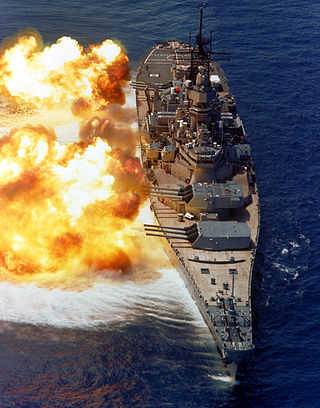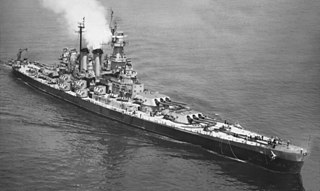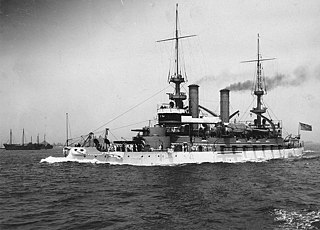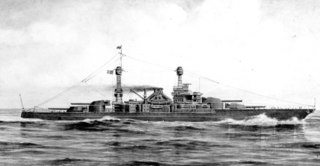
The Montana-class battleships were planned as successors of the Iowa class for the United States Navy, to be slower but larger, better armored, and with superior firepower. Five were approved for construction during World War II, but changes in wartime building priorities resulted in their cancellation in favor of continuing production of Essex-class aircraft carriers and Iowa-class battleships before any Montana-class keels were laid.

The Iowa class was a class of six fast battleships ordered by the United States Navy in 1939 and 1940. They were initially intended to intercept fast capital ships such as the Japanese Kongō class while also being capable of serving in a traditional battle line alongside slower battleships and act as its "fast wing". The Iowa class was designed to meet the Second London Naval Treaty's "escalator clause" limit of 45,000-long-ton (45,700 t) standard displacement. Four vessels, Iowa, New Jersey, Missouri, and Wisconsin, were completed; two more, Illinois and Kentucky, were laid down but canceled in 1945 and 1958, respectively, before completion, and both hulls were scrapped in 1958–1959.

The Wyoming class was a pair of dreadnought battleships built for the United States Navy. Wyoming and Arkansas were authorized in early 1909, and were built between 1910 and 1912. These were the fourth dreadnought design of the US Navy, but only an incremental improvement over the preceding Florida class, and the last US battleships to use 12-inch guns. The primary changes were the adoption of a more powerful 12 in (305 mm)/50 caliber Mark 7 gun, addition of a sixth twin-gun turret and improved armor protection, including the first use of a torpedo bulkhead on American battleships. The Navy considered using more powerful 14-inch (356 mm) guns, but this would have caused delays and required larger docks.

The North Carolina class were a pair of fast battleships, North Carolina and Washington, built for the United States Navy in the late 1930s and early 1940s.

The Nevada class comprised two dreadnought battleships—Nevada and Oklahoma—built for the United States Navy in the 1910s. They were significant developments in battleship design, being the first in the world to adopt "all or nothing" armor, a major step forward in armor protection because it emphasized protection optimized for long-range engagements before the Battle of Jutland demonstrated the need for such a layout. They also introduced three-gun turrets and oil-fired water-tube boilers to the US fleet. The two Nevadas were the progenitors of the standard-type battleship, a group that included the next four classes of broadly similar battleships that were intended to be tactically homogeneous.

The New Mexico class was a class of three super-dreadnought battleships built for the United States Navy in the late 1910s. The class comprised three ships: New Mexico, the lead ship, Mississippi, and Idaho. Part of the standard series, they were in most respects copies of the Pennsylvania-class battleships that immediately preceded them, carrying over the same main battery arrangement of twelve 14-inch (356 mm) guns, but now increased to 50-caliber. They incorporated several other improvements, including a better arrangement of the secondary battery that increased its usability, a clipper bow that improved seakeeping, and an experimental turbo-electric propulsion system adopted on New Mexico. Like the other standard-type battleships, they had a top speed of 21 knots that allowed the fleet to operate as a tactically homogeneous unit.

The Colorado-class battleships were a group of four United States Navy super-dreadnoughts, the last of its pre-Treaty battleships. Designed during World War I, their construction overlapped the end of that conflict and continued in its immediate aftermath. Though all four keels were laid, only three ships entered service: Colorado, Maryland, and West Virginia. Washington was over 75% completed when she was canceled under the terms of the Washington Naval Treaty in 1922. As such, the 16" gun Colorado-class ships were the last and most powerful battleships built by the U.S. Navy until the North Carolina class entered service on the eve of World War II.

The Kearsarge-class was a group of two pre-dreadnought battleships built for the United States Navy in the 1890s. The two ships—USS Kearsarge and USS Kentucky—represented a compromise between two preceding battleship designs, the low-freeboard Indiana class and the high-freeboard USS Iowa, though their design also incorporated several improvements. Their primary advances over earlier designs consisted of new quick-firing guns and improved armor protection, but their most novel feature was their two-story gun turrets that consisted of a secondary 8-inch (203 mm) gun turret fixed to the top of their primary 13-inch (330 mm) turrets. The ships suffered from a number of problems, however, including a tertiary battery mounted too low in the hull and poorly-designed turrets, though the latter were attempted again with the Virginia class in the early 1900s, also with negative results.

The Connecticut class of pre-dreadnought battleships were the penultimate class of the type built for the United States Navy. The class comprised six ships: Connecticut, Louisiana, Vermont, Kansas, Minnesota, and New Hampshire, which were built between 1903 and 1908. The ships were armed with a mixed offensive battery of 12-inch (305 mm), 8-inch (203 mm), and 7-inch (178 mm) guns. This arrangement was rendered obsolete by the advent of all-big-gun battleships like the British HMS Dreadnought, which was completed before most of the Connecticuts entered service.
The Bureau of Aeronautics (BuAer) was the U.S. Navy's material-support organization for naval aviation from 1921 to 1959. The bureau had "cognizance" for the design, procurement, and support of naval aircraft and related systems. Aerial weapons, however, were under the cognizance of the Navy's Bureau of Ordnance (BuOrd).
The Bureau of Naval Weapons (BuWeps) was part of the United States Navy's material organization between 1959 and 1966, with responsibility for procurement and support of naval aircraft and aerial weapons, as well as shipboard and submarine naval weapons. The bureau was established August 18, 1959, by an Act of Congress. The Act merged the Bureau of Aeronautics (BuAer), which had responsibility for naval aircraft and related systems, and the Bureau of Ordnance (BuOrd), which had responsibility for naval weapons.
The Bureau of Ordnance (BuOrd) was a United States Navy organization, which was responsible for the procurement, storage, and deployment of all naval weapons, between the years 1862 and 1959.

The Advanced Gun System (AGS) is a naval artillery system developed and produced by BAE Systems Armaments Systems for the Zumwalt-class destroyer of the United States Navy. Designated the 155 mm/62 (6.1") Mark 51 Advanced Gun System (AGS), it was designed to provide long range naval gunfire support against shore-based targets. A total of six of the systems were installed, two on each of the three Zumwalt-class ships. The Navy has no plans for additional Zumwalt-class ships, and no plans to deploy AGS on any other ship. AGS can only use ammunition designed specifically for the system. Only one ammunition type was designed, and the Navy halted its procurement in November 2016 due to cost, so the AGS has no ammunition and cannot be used. The Navy will remove the AGS from the ships in 2023.
The United States Navy's Bureau of Ships (BuShips) was established by Congress on 20 June 1940, by a law which consolidated the functions of the Bureau of Construction and Repair (BuC&R) and the Bureau of Engineering (BuEng). The new bureau was to be headed by a chief and deputy-chief, one selected from the Engineering Corps and the other from the Construction Corps. The chief of the former Bureau of Engineering, Rear Admiral Samuel M. "Mike" Robinson, was named BuShips' first chief, while the former chief of the Bureau of Construction & Repair, Rear Admiral Alexander H. Van Keuren, was named as BuShips' first Deputy-Chief. The bureau's responsibilities included supervising the design, construction, conversion, procurement, maintenance, and repair of ships and other craft for the Navy; managing shipyards, repair facilities, laboratories, and shore stations; developing specifications for fuels and lubricants; and conducting salvage operations.

The first South Dakota class was a group of six battleships that were laid down in 1920 for the U.S. Navy, but were never completed; designed to achieve 23 knots, they represented an attempt to catch up with the increasing fleet speeds of its main rivals, the British Royal Navy and Imperial Japanese Navy.

The 1.1"/75 caliber gun was an American anti-aircraft weapon of World War II, used by the United States Navy. The name means that it had a bore diameter of 1.1 in (28 mm) and barrel caliber of 75. The gun was designed to replace the M2 Browning and four barrels were required to duplicate the rate of fire.

Admiral Samuel Murray Robinson was a United States Navy four-star admiral who directed Navy procurement during World War II.

The General Board of the United States Navy was an advisory body of the United States Navy, somewhat akin to a naval general staff and somewhat not. The General Board was established by general order 544, issued on March 13, 1900 by Secretary of the Navy John Davis Long. The order was officially recognized by Congress in 1916. The General Board was disbanded in 1951.

The Ship Characteristics Board was a unit of the United States Navy.

The CL-154 class of 5-inch (127 mm) gun light cruisers was a United States Navy project from the last two years of World War II, with antecedents reaching back to 1938 and earlier. The CL-154 class was contemporary to the 6-inch (152 mm) gun Worcester-class light cruisers and the 8-inch (203 mm) gun Des Moines-class heavy cruisers: like them the CL-154 design incorporated the lessons learned of World War II combat. The Navy allocated six hull numbers to the CL-154 class for the planned construction, but unlike the Worcester and Des Moines classes the CL-154 class would be cancelled with no units named or constructed. Had these ships been built, they would have been given the hull classification CLAA on 18 March 1949.















